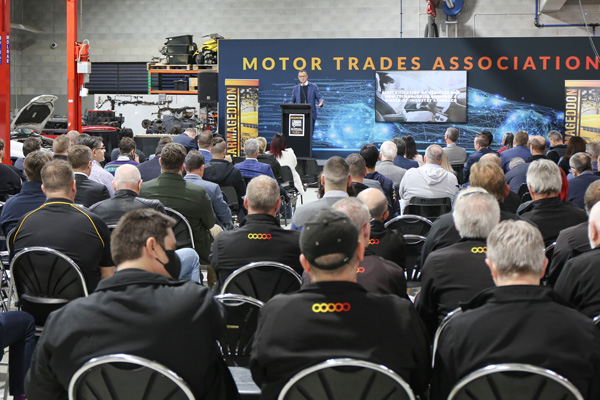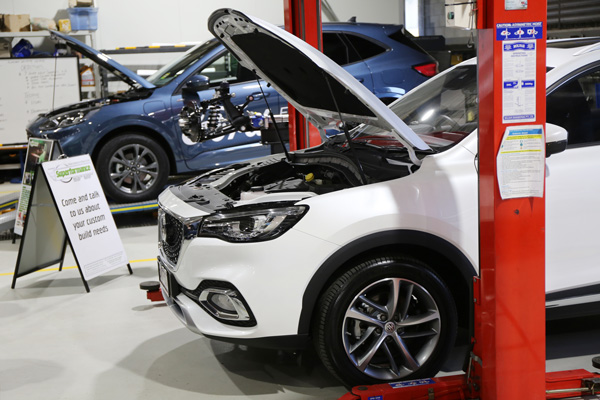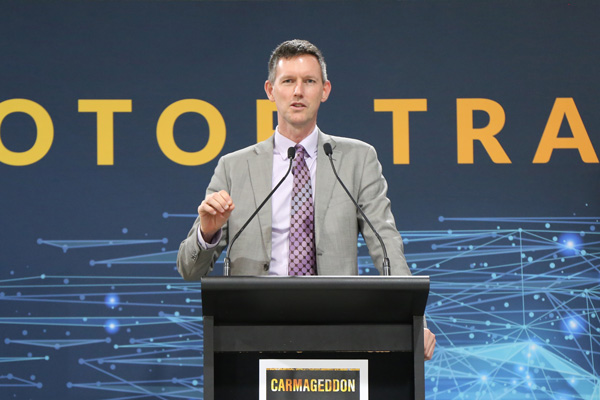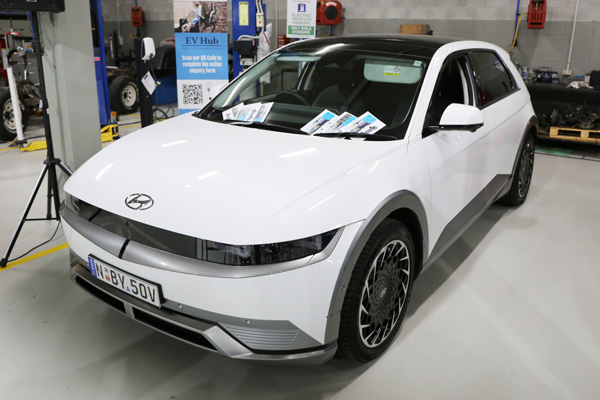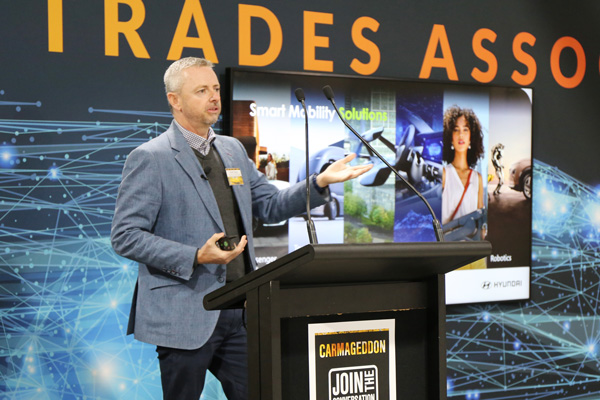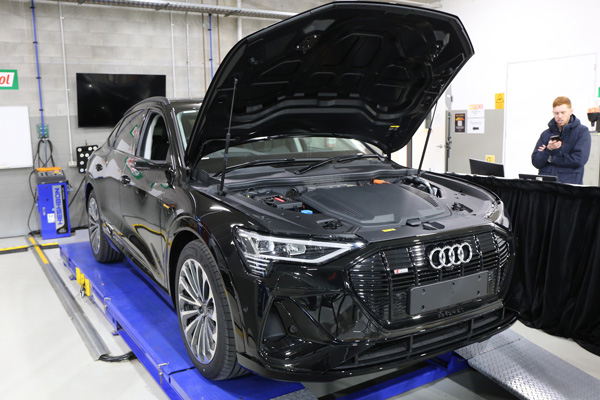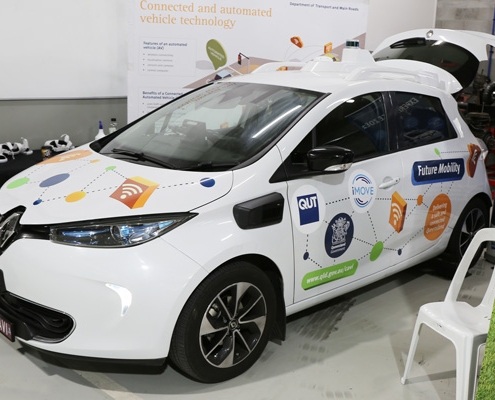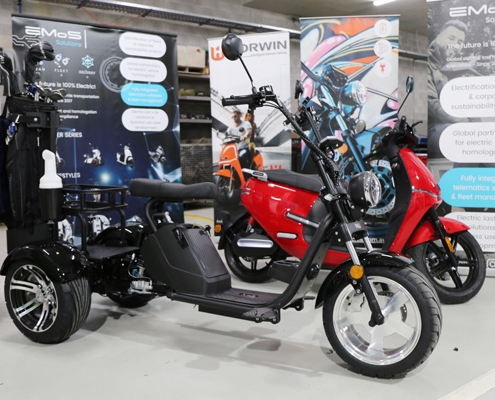Carmageddon 2022 | The Challenges and Opportunities of an Auto Industry Transition
While there may be much discussion and debate about the timing, there really is little doubt that the future of the automotive industry is electric.
It may well take years for the electric revolution to be completed – with challenges around infrastructure, government policy, price, public acceptance, industry workforce upskilling and other hurdles still to be negotiated, but ignoring the fact that most of the nations to which Australia compares itself, and which are the home of the manufacturers building the vehicles we drive, are moving inexorably to electrifying their fleets would be irresponsible.
Facing up to the challenges and examining some of the directions and opportunities that Australian automotive businesses may take over the next few years was the dominant question considered at the fifth edition of MTA Queensland’s Carmageddon symposium – a one-day forum that has, since its debut in 2017, aimed at highlighting and discussing the innovations, technologies, and trends that will shape the industry, across all sectors, in the near future.
Held on July 28 at the MTA Queensland head office in Brisbane, the 2022 Carmageddon forum brought together more than 100 industry leaders, government representatives, business owners, academics, and MTA Queensland members to discuss the issues that face the industry.
On display were examples of some of the technology that is making its way into the local market, with battery-electric, hybrid, and hydrogen fuel cell vehicles from manufacturers such as Audi, Hyundai, MG, Ford, and JAC Motors, along with a converted electric vehicle from Brisbane-based Oz DIY Electric Vehicles, and two-wheel electric scooters and bikes from Australian companies EMoS Australia and Benzina Zero. Also being presented was a Level 4-capable autonomous research vehicle from the Queensland University of Technology (QUT), an independent front suspension unit designed and built in-house by MTA Queensland member Superformance; and the latest tools from Milwaukee Tool.
Representatives from OurAuto were also on hand to discuss the products and services that organisation has to offer automotive businesses.
Following a Welcome to Country from Louisa Bonner – descendant of the Jagera/Ugarapul, Yaggera Language people – and an opening statement from Paul Peterson, Chair of the MTA Queensland Board, the Hon Mark Bailey MP, Queensland Government Minister for Transport and Main Roads addressed the forum, noting that the Queensland Government was working to make electric vehicles (EVs) easier to use and buy through initiatives like the electric superhighway and subsidies, and that the transition to electrification offered ‘tremendous opportunities’ but also presented ‘tremendous challenges.’
The Minister commented on EVs as being part of a wider strategy on grappling with climate change.
“There are a lot of ways of combating climate change, and certainly getting into new technology and cars is one important arm to that,” he said.
“But aside from that, it is just better technology. We all love cars, and different kinds of cars. Some of us love the big throaty roar of a V8, and that’s all good, but the reality is that once you’ve tried and got used to an EV, it’s pretty hard to go back. And emerging technology is getting better and better and better . . . this is a massive time of transition and change.”
Talking about the challenges ahead, the Minister noted the skills shortage, the recognition that more will be done to smooth the transition to EVs, and the exciting future a shift to new fuel technologies offers.
“There will be real challenges – skills are something that are going to be a real challenge and particularly at a time when the jobless rate is at historic lows,” he said. “I know the MTAQ are right in there, working with industry to make sure the skilling challenge is being met, and that it is a tremendous opportunity for people to get into the industry and be set up for a long time.
“Five years ago, there were 500 electric vehicles in Queensland, there are now more than 10,000. We’ve increased – off a low base admittedly – by 2000 per cent. What has partly held us back is a lack of national leadership . . . we have been dragging the chain compared to most other developed nations, but the new Albanese government has made it very clear that they want to be part of the solution. They’ll be removing the import duty and the Fringe Benefit Tax on electric vehicles, and we will continue to work with them and other states to ensure this transition happens.
“Obviously, hydrogen is a really important part of that future as well… In Queensland and in Australia, we have tremendous opportunities in terms of green hydrogen going into the Asian market of 3 billion people. We have a huge amount of space, huge amount of sunlight, a developed economy, lots of ports… and our department is lined up to work with companies in Asia to get those hydrogen deals sealed and for us to get into that part of the world energy mix.”
Following the Minister’s address, the first keynote address was delivered by MTA Queensland’s CEO, Rod Camm. As the Minister did, Mr Camm focused on the opportunities and challenges of the transition to electrification, commenting that more needed to be done on beefing up infrastructure, on incentives, on formulating a national response that includes elements such as fuel standards, and on recognising that while EVs, hybrids and, perhaps, hydrogen fuel cell vehicles represent the future, internal combustion engine vehicles are not going to disappear.
He also noted that in the national conversation about battling emissions and climate change, the automotive industry had become a central point of debate. That, he said, focused attention on an industry that was only part of the answer to the emissions question, but it also helped stimulate automotive industry leaders to unite to find solutions, something highlighted by the meeting of state and national organisations – including MTA Queensland – that occurred in July.
“At the heart of this really important debate at the moment is the automotive industry,” said Mr Camm. “All you previously heard about are things like coal, but now they are talking about the technology rushing through the automotive industry. Yes, our industry is the cause of about 18 per cent of emissions, so we recognise it is important, but there is a risk in this discussion, and that risk is that the solutions only seem to be electric vehicles. Nothing could be further from the truth.”
However, the industry was taking its responsibility seriously and electric car conversions; shared mobility; electric mobility in the form of scooters, motorbikes and other urban-focused vehicles; hybrid and hydrogen fuel cell technology; and infrastructure were part of the solution, he suggested. Governments must play their part too.
“When you look across the world, other countries, particularly in Europe, are well ahead and are looking at non-financial incentives around transit lanes, free parking, free charging and the like.
“The Minister mentioned that not just Queensland but other states have stepped forward in light of a lack of a national response, but car manufacturers are looking for national uniformity – a national position. I sense this is now a live discussion and that will help us enormously.”
Noting that the suggestion had been made that by 2030, 50 per cent of new vehicles will be electric, Mr Camm said that meant EVs would still constitute just a fraction of the total vehicle fleet, with internal combustion engine vehicles remaining dominant in the transportation landscape.
“It is great to have ambition . . . but even if that was achieved, the reality is that in 2030 electric vehicles will constitute about 8 per cent of the total vehicle fleet. That tells us that we can’t forget about internal combustion engines.
“We want to respect that legacy fleet because all our independent repairers and dealerships have to keep focusing on their business, so there’s a risk around just focusing on electric vehicles.”
Regarding EV uptake, Mr Camm commented on the various reasons that might be hindering the penetration into the local market. He highlighted that 2.3 million EVs were sold in Europe last year and that while the Australian EV market experienced impressive growth, sales here reached just 20,000 units in 2021.
Fuel standards, he said, would go some way to enabling manufacturers to bring in more and better hybrid vehicles, as would more and better subsidies, and a greater choice of electrified cars would lead to better prices, enabling more Australians to get into hybrids and EVs.
“89 per cent of electric vehicles in Australia are above $50,000,” he said. “In Europe, the reverse is true but only because of national-level subsidies and the like. So that’s important. We’ve still got some pretty good cars available at that lower price but the more we can make it competitive, the better.”
The transition to electrification would, Mr Camm said, be tough, and some businesses would be affected. Training too, would have to adapt to the new reality, and more effective strategies to grapple with the perennial issue of skill shortages would have to be adopted.
“The experience of Norway is that up to 20 per cent of independent businesses – largely mechanical repairers – can be expected to close over the journey,” he said. “We don’t want that because the tail is long – by 2030 more than 90 per cent of vehicles will still be powered by internal combustion engines.
“The challenge around skills is that we are in a competition in a tight labour market. We need to be able to reach into schools and we do have a strategy that we are working on . . . We have been working really hard with government, and there is a Gateway Skills Program for which we are lobbying.
“We completed an apprenticeship survey recently . . . and the message there was that kids love automotive but want to know what the future looks like. By the time they get to the fourth year of their apprenticeship, they’re over it, and we need strategies to keep them sticking.
“So there is lots to do, but my main message today is that we embrace electrification . . . We are absolutely unified as an industry on this initiative.”
Following Mr Camm’s address, he held an interview with Andrea McCarthy, owner of McCarthy Panel Works in Mackay who is also a Director on the Board of MTA Queensland, a member of I-CAR Australia’s Industry Advisory Board, and Chair of MTA Queensland’s National Auto Collision Alliance division.
Passionate about the repair industry, Ms McCarthy is also a mentor in MTA Queensland’s Auto Women project – a project aimed at providing a supportive environment for women working in the industry – and is a recipient of the first Executive Ready Auto Women Scholarship from Women & Leadership Australia.
Under the guidance of Ms McCarthy and husband Craig, McCarthy Panel Works has made significant moves in preparation for the expected influx of electrified vehicles over the next few years, expanding facilities to include a specialised centre for electric and hybrid vehicle repairs.
While they had already begun to invest in the expansion, the business did receive $50,000 in State Government funding via the Government Business Growth Fund to assist in completion of the venture. Such funding is, of course, extremely useful and Ms McCarthy explained how she had been successful in her grant application – an explanation that offers a good guide for other businesses that may wish to make a pitch for funding.
“Ultimately every transaction you do and every conversation you have comes back to negotiating. What does this person need, what do I need and how do we marry the two together?” she said. “We were able to look at the situation and say, ‘The government wants to create an electric super highway, we are part of that highway, how do we marry those things together?’
“My proposal was designed around what the government needed and what we were already looking to do in our business . . .”
Ms McCarthy further highlighted the need for business owners to fully accept that change was inevitable and to move forward on that basis.
“One of the things I see as being the biggest issue the repair industry has to overcome is ourselves . . . We need to take ownership of what happens and start taking the next step forward,” she said.
“If we keep rehashing the same things, we are never going to make a change. Own it, move past it.”
HYDROGEN: THE FUEL OF THE FUTURE
The second keynote address of the day was delivered by Scott Nargar, Senior Manager of Future Mobility and Government Relations for Hyundai.
Hyundai is a big advocate of hydrogen technology, using fuel cell powertrains for its Nexo SUV and Xcient heavy-duty trucks, and Mr Nargar focused on that technology and the wider electrification strategy Hyundai was implementing.
Hydrogen is to play a major part in Hyundai’s pursuit of lower emissions, and the company was a founding member of the Australian Hydrogen Council – which has, as one objective, the aim to ‘accelerate the commercialisation of new hydrogen and fuel cell technologies for transportation, export, storage and stationary applications in Australia.’
The potential for hydrogen in Australia is massive, said Mr Nargar, and the country was well positioned to be a major player in the industry both as a user and manufacturer and exporter.
Like other new technologies, having the infrastructure to make it appeal to car buyers will take work, and heavy vehicles might be the catalyst for more refuelling stations. Europe seems to be the place to which Australia might look for inspiration.
“It is really going to happen with buses and trucks to justify the cost of stations,” said Mr Nargar. “Stations are expensive, and while cars use 6.3kg of hydrogen to do 600-700kms, a truck or a bus needs 35-55kg every single day. If you are going to invest in infrastructure, you want many trucks and buses running off your service station.”
In Germany, he added, there are 96 operational public hydrogen stations with another nine currently under construction, and there are many more private stations owned by bus and truck operators. Five years ago, in Frankfurt, there was one hydrogen station, now there are six. It was hoped, said Mr Nargar, that something similar will happen here, with the potential of hubs, or clusters of hydrogen stations, offering manufacturers the confidence to deploy more cars into the country.
As with battery-electric vehicles, hydrogen fuel cell vehicles have fewer moving parts than their combustion engine counterparts. While that might mean the servicing requirements are fewer, the technology demands high quality training be delivered to future technicians and Mr Nargar said Hyundai was working with the Queensland Government on the codes and standards around the vehicles and the technician training.
“Like an EV, there are only a couple of main components,” he said. “We’ve got the fuel cell and the drivetrain at the front with an electric motor, and there are hydrogen tanks in the back of the vehicle . . . There is not a whole lot of servicing requirement but the technicians who work on these cars need to be expert in high voltage and experts in high pressure gas.”
While there are currently only a handful of hydrogen fuel cell vehicles on the road in Australia, and only a small number of places to refuel them, the technology is well-proven. It will likely find its place within the national fleet, following the path that other countries have set out, and this means it must be something automotive businesses consider as they contemplate their future plans.
“The future is now, the cars are here,” said Mr Nargar. “The tech is coming, accept it, believe in it, train on it, upskill your staff and yourself and be prepared for the tech that is here right now.”
SERVICE STATIONS OF THE FUTURE
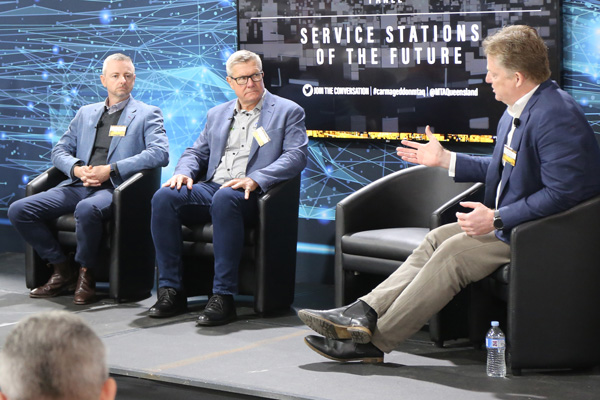
Scott Nargar, Paul Wessels, and Paul Guy joined ACAPMA CEO Mark McKenzie (pictured below) in a discussion on the future of service stations
The second panel discussion of the day focused on service stations and, more specifically, on how service stations can evolve to meet the twin challenges of a gradual reduction in the size of the internal combustion engine fleet and an increase in the number of battery-powered vehicles requiring charging.
On the panel were Scott Nargar from Hyundai; Paul Guy, Managing Director of Smart EV Solutions; and Paul Wessel, Principal of Wessel Petroleum, which operates 20 service stations in Queensland, and a Queensland Board member of ACAPMA – the Australasian Convenience and Petroleum Marketers Association. The facilitator of the panel was Mark McKenzie, CEO of ACAPMA.
It is clear that ACAPMA has been wrestling with the question of electrification for some time and Mr McKenzie played a video showing a possible service station of the future that is as much a ‘community hub’ as a refuelling or recharging site. The station concept included interactive consoles; virtual meeting spaces for business; play areas for children; 3D printing areas; and even a drone hub designed to leverage a station’s position as a potential delivery facillity. A futuristic concept it may have been, but it was also an indication that the sector is well along in its thinking about absorbing EV charging (and the longer time customers may stay at its locations) into its plans for the future.
And in such a large a industry sector, it is important that they are thinking ahead and asking questions about when they should invest in technology such as EV chargers, when fossil fuel delivery may become a thing of the past, and if hydrogen will be a feature of the industry.
“The key issue here when you start to think about the service station industry is that it is an industry that employs 48,000 Australians, there are 7,800 sites, and we support sales of 27 billion litres of fuel that supports a motor vehicle fleet of 20.1 million vehicles,” said Mr McKenzie.
“Less than 0.25 of 1 per cent of those vehicles are electric and hybrid. That is where we sit at the moment. So there is a big gap between where we are aspiring to be and where we are now, and when you have $30 billion of assets under your stewardship and you’re making an investment in those assets today that will define the archetype of the forecourt in the next 15 years, we have to be right ahead of the curve.”
That curve demands plenty of careful consideration.
“It is well beyond an argument about whether we are going to go to EVs or hydrogen . . . the challenge is when and how we develop an investment profile that is reasonable and we don’t get so far in that we end up with a squeeze that drives up the price of conventional fuel because we retired those assets too early. That’s the challenge.”
The subject of EV charging included discussion around the cost of installing and running charge points, the ability of the grid to support charger installation, the return on investment, and when such investment should take place.
The consensus around charge points was that those delivering 150kW of power were optimal, offering a relatively fast charging time. Anything less powerful would mean not enough vehicles could be pushed through a station. The performance of the electricity grid was considered vital too, with the example raised of one location having to invest not only in the chargers themselves, but also in the connection of the site to the grid – a scenario that meant the station was actually investing in the grid, an asset it does not own.
Also considered was timing. With the estimate being that only about 8 per cent of the total vehicle fleet to be electric by 2030, when to invest heavily in charging points is a vexing question.
What was not questioned was that change is inevitable. With manufacturers working in and for a global market, these vehicles are coming, and every industry has to adjust.
“We can’t leave the legacy fleet behind – it’s still going to be the mainstay for the next 20 years in our industry, so we have to find a way to diversify the forecourt with sound economic and investment solutions . . . that’s a challenge we are all dealing with at the moment,” said Mr McKenzie.
While there are plenty of real brow-furrowing challenges for the service station industry to consider, there was no doubt amongst the panel that the industry would adjust and survive.
“Service stations will not fade off quietly in the distance, they will adapt,”said Mr McKenzie.
RECYCLING AUTOMOTIVE PLASTICS
The third keynote address of the day was delivered by Sarfraz Ali Kyani, PhD Candidate and Sessional Academic at Queensland University of Technology.
Sarfraz has been researching automotive recycling and presented data and insight into a potential opportunity for new businesses in Queensland. Focusing on the recycling of plastic vehicle bumper bars, Sarfraz gave a rundown of his research that led to the conclusion a new industry is ready to be created through recycling this component.
Sarfraz proposed that businesses – requiring relatively small investment – can be established in Queensland to collect and shred bumper bars, recycle the plastic and either export the much in-demand recycled PPE pellets, or manufacture, through such technology as 3D printing, a vast variety of products.
Such an enterprise, he said, would benefit from, among other things, external enablers such as governments looking to become ‘greener’ by regulating the use of recycled material for products used in, for example, schools and other public places. Also available, Sarfraz noted, were Government grants and ‘green’ loans from financial institutions, both of which were becoming accessible for ventures centred around the circular economy.
You can find out more about Sarfraz Ali Kyani and his work and research HERE.
AUTOMOTIVE WORKFORCE CRISIS
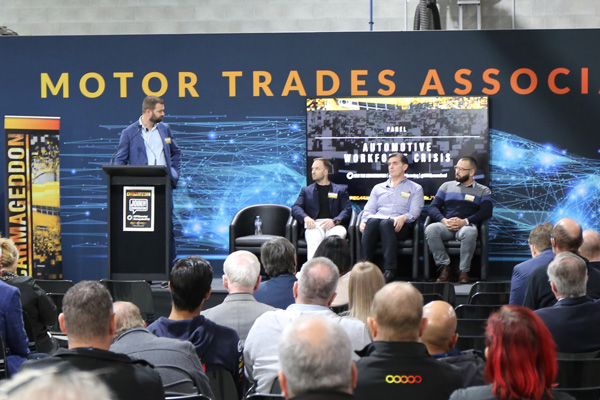
James Voortman, CEO of the Australian Automotive Dealer Association, led a discussion on the workforce crisis and was joined by Eden Spencer, John Girardi, and Nick Manolis
The third panel discussion of the day revolved around the seemingly never-ending problem of finding, training and keeping skilled staff. According to the 2021 Directions in Australia’s Automotive Industry report from the Motor Trades Association of Australia, ‘50 per cent of automotive businesses are experiencing a shortage of skilled labour . . .’ and the ‘. . . industry skills deficit is forecast to increase to an estimated 38,700 skilled positions by 2022/23.
The panel included Eden Spencer, CEO of The Skill Xchange; John Girardi, Director of Girardi Human Resource Services; Nick Manolis, Managing Director of Genesis Autoworks; and James Voortman, CEO of AADA (Australian Automotive Dealer Association) who also acted as facilitator.
There were some very interesting perspectives and insights offered by the panel as they tackled what is currently a pretty nasty situation. So bad is it, in fact, that Mr Girardi offered a truly incredible anecdote regarding the desperation of some businesses to keep hold of staff, no matter the situation.
He had, he said, worked with a client who’d had an employee steal from them but who kept that employee on because it would just be too difficult to replace them. Astounding.
The panel discussed what strategies could be implemented to create an environment that appeals to good staff and encourage them to stay, and these included ensuring good communication channels were open; that there were opportunities for, and clear pathways to, advancement; that ongoing and relevant training was available; and that rewards – not just of the financial kind – were achievable.
Diversity too, was discussed, with Nick Manolis noting that attracting more women into the industry just made sense and that there was little logic in ignoring 50 per cent of the population. At Genesis Autoworks he employs 15 staff and has four female employees, and their presence was a positive, he said, with other women, upon seeing them in the workshop, confident enough to approach him about the possibility of starting an automotive career.
“There’s definitely the recurring theme that having them visible in our business we are getting quite a lot of interest,” he said. “We don’t have the ability to take them all on because we have to stay within certain caps of tradespeople to apprentices, but I have a waiting list of females wanting to do apprenticeships.”
Another angle to tackle the skills shortage was raised by Eden Spencer, who argued that if the still widely held view of the automotive industry as one that is rugged and dirty could be changed, more young people would be interested.
“I don’t know if we are spending enough time and effort in considering how to present automotive in a modern light and modern fashion,” he said. “I was drawn to the industry because of technology and innovation . . . and I don’t think that image of the industry is really getting through to the potential new entrants we need to come in to fill the skills shortage.
“On top of that, having a skills shortage does have some benefits . . . you have job security, you have job stability, and that is something that is industry wide. If you are great at your job, there is always going to be opportunity there, and that needs to be sold to potential new entrants.”
SAFETY FEATURES AND TECHNOLOGY
The last keynote of the day was delivered by Carla Hoorweg, CEO of the Australasian New Car Assessment Program (ANCAP) who gave a comprehensive rundown of that organisation’s work, the additions to the testing program that it had brought in as vehicle technology has progressed, and the proposed new tests that ANCAP will be initiating in the coming year.
For example, in 2023, Ms Hoorweg said ANCAP would be assessing the ability of a vehicle to detect the presence of child left in a vehicle and how it might alert the absent driver. Also on the cards was vehicle submergence technology, and how it might help enable emergency services to access a vehicle that is underwater – something, she said, that was of interest given the recent flooding in NSW and Queensland.
“Most vehicles have powered windows and doors . . . we take this power technology for granted, but it can be problematic if the vehicle is submerged,” she said. “What we are going to look at from 2023 is the ability of the vehicle to allow occupants to escape, or for rescuers to access occupants and open the door. So we will be looking at whether car doors can be opened without battery power and whether the electric windows remain functional for up to 10 minutes after submergence.”
ANCAP also aims to expand its testing program to other vehicle types, including heavy vehicles and motorcycles.
The mission of ANCAP is, said Ms Hoorweg, to protect road users by improving new vehicle safety and promoting safer vehicles, and its work over 30 years had been instrumental in reducing the number of deaths and serious injuries on Australian and New Zealand roads.
“The majority of new cars entering the market are achieving 5-star ANCAP safety ratings, and this is continuing even though every two years we increase the requirements, lift the bar, change the tests, and change the scoring to make it harder to satisfy,” she said. “Today, we see very good results, we see 5-star cars, we see strong structures, multiple airbags, lower risk of injury, and survivable crashes. I think that demonstrates what the point of the program is.”
Dealerships
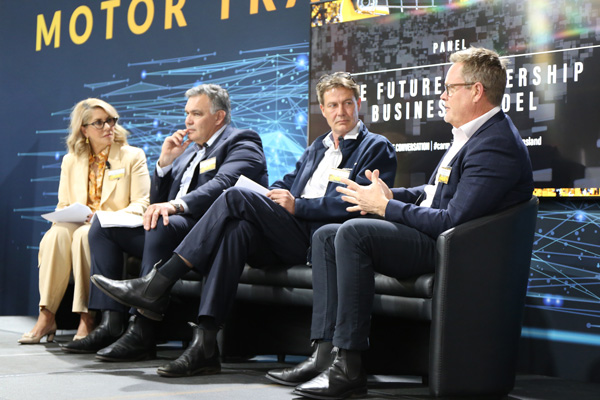
The discussion on the future of dealerships was chaired by Tania Meli, who was joined by Nick Pappas of Servco, Fraser Brown of Q Automotive, and Mark Woelders of Motorama
The final panel discussion of Carmageddon 2022 focused on vehicle dealerships.
The panel included Tania Meli, an executive with Frizelle Sunshine Automotive and Dealer Principal at Audi Centre Gold Coast and Ferrari Cold Coast; Nicholas Pappas, Group Managing Director for Servco Australia; Mark Woelders, Managing Director of Motorama; and Fraser Brown, Dealer Principal for Q Automotive.
With all the panellists having spent many years in the industry leading large dealership groups and locations, the discussion gave some really in-depth insight into what is being contemplated at the top echelons of that sector.
Electric vehicles were, once again, front and centre of the discussion, with talk of the investment (and who provides it) required to install chargers at dealerships; the constant improvements in EV technology, and the need to be diversified and invest in this new technology while also still providing quality service for internal combustion engine vehicles.
Nick Pappas of Servco – which amongst other brands, has more than 15 Toyota dealerships across the country – spoke about the long lead-in time for EVs to reach critical mass, saying that the EV market is less than two per cent and needs to reach 10 per cent to get the attraction of the mass market. Toyota’s experience with hybrid vehicles was, he said, an example of how things can play out.
“Hybrids are a big part of our market – almost 10 per cent of the market now,” he said. “We started that journey with Prius back in 1993, so it has been almost 30 years to get to where we sit today and to get the hybrid to 10 per cent of the market . . . If you apply that logic to EVs, assuming they are three times as fast, that is 10 years out. So it is a long game, and we are at the start of a long tail.”
Digitalisation – that is the use of digital technologies to change a business model and provide new revenue and opportunities – was also discussed heavily, and given public acceptance of online purchasing during COVID, the concept is high on the list of priorities for dealers.
It was suggested there were some who believe digitalisation may see the business model change so that dealers – no longer the single touchpoint for customers – will become more about the physical assets and the experience of a test drive, vehicle delivery and service. The OEM, meanwhile, will take care of the online experience, the sale, the configuration, the accessorising, the financing and insuring of the transaction. The agency model, which looks much like this, is now an entrenched, if controversial, business concept.
Digitalisation also captures the phrases ‘multi-channel’ and ‘omni-channel’.
Customers, though they may still appreciate the human touch afforded by test drives and the like, now expect to be able to deal and interact with brands, OEMs, and dealerships across multiple channels, and a ‘multi-channel’ approach sees businesses approach each one – be it newspapers, television, or facebook and other social media – differently, telling different but tailored stories across each platform. ‘Omni-channel’ sees a business take a more focused approach and tell a single story or concept across all channels and platforms.
While this may seem just a difference in marketing, the panel considered how individual dealership businesses may want to retain some measure of control over what was put out across their own channels.
Customer data also comes into the digitalisation conversation. Connected vehicles create vast amounts of potentially very valuable data and the panel discussed that, traditionally, when a customer bought a vehicle, they owned the vehicle and what is in it. Today, however, with technology such as telematics, who owns that data? The car company? Dealers, it was suggested, need to get data literate in this area, and understanding data and how it can be safely stored and used opens a whole new area regarding employees and skillsets. A dealership may once have been the domain of salespeople, finance specialists and mechanics – but data professionals are an employee sector that must now be considered.
On the subject of employees, the group also discussed what a dealership would need in terms of skilled employees in the future, and how the ongoing skills shortage can be overcome.
As was also highlighted in the Automotive Workforce Crisis panel discussion, the dealership leaders were united in that a focus on retaining through training, culture, and progression plans was vital, and that ‘selling’ the industry to young people was critical.
“We have got to grow our own rather than competing,” said Mark Woelders. “It comes back to the industry to start planting seeds that become trees . . . It really starts with the young and making sure they know it is exciting . . . We need to do a much better job of painting that career path for them for the future. Not everyone wants to be a technician forever, not everyone wants to be a salesperson forever, and as a business we have a lot of different opportunities to progress. We just don’t necessarily do a very good job of telling people.”
Ultimately, suggested Mr Woelders, dealerships are ready to face the challenges the sector faces in the coming years.
“Resisting change is like trying to hold your breath,” he said. “It doesn’t end well.
SEE YOU IN 2023
The 2022 edition of Carmageddon was particularly fruitful, and as the industry’s transformation picks up speed in the coming years, the symposium will become an even more important event on the industry’s calendar. It has become a leading platform for the showcasing of, and discussion around, the new technologies affecting the automotive industry, and it has become an important part of MTA Queensland’s mission to highlight the challenges these bring, and the potential opportunities for businesses to thrive as the market changes.
See you next year.
Source: Motor Trader e-Magazine (August 2022)
15 August 2022




